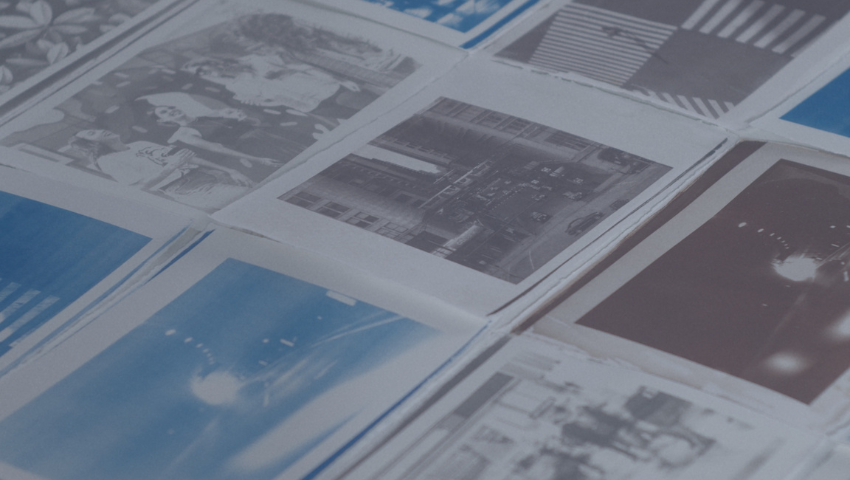Image Credit: Photography taken by Kenta Yamamoto
According to SIGGRAPH 2023 contributor Chinatsu Ozawa, the world of photography has evolved significantly in the past 80 years. The evolution from film to digital cameras has lead to many changes in photography techniques. By blending digital technology with handmade photography, the creative opportunities are endless. We sat down with Ozawa to talk about forging a new pathway for artistic expression.
SIGGRAPH: What inspired the idea of combining digital technology with the experience of the handmade photography process?
Chinatsu Ozawa (CO): The inspiration behind blending digital technology with a handmade photography process stems from two fundamental interests. First, there is a fascination with exploring the intersection between the digital and analog realms. This intersection is a fertile ground for innovation, where the precision and scalability of digital technology can be harmoniously married with the tactile and intimate nature of analog methods. By employing digital means to manipulate and enhance handmade photographic processes, we are able to create a bridge that brings together the best of both worlds, forging a new pathway for artistic expression.
Second, in today’s fast-paced and technology-driven age, there is a growing appreciation and interest in the craftsmanship and folk art. These traditional art forms have an inherent value that speaks to our shared human heritage and the skills passed down through generations. They remind us of the patience, dedication, and soul that goes into creating something with our hands. Combining this with digital technology not only preserves these valuable art forms but also evolves them in ways that are contemporary and relevant. This synergistic combination allows artists and creators to continue to engage in meaningful craftsmanship while embracing the conveniences and possibilities of the digital age.
SIGGRAPH: How does your work allow for others to express more creativity within their photography?
CO: We have integrated computational technology to manipulate the tones of the photographs. By adjusting the parameters of the negatives through a graphical user interface (GUI) on a computer, one can easily control the tonal range in monochrome alternative processes. This replaces the need to adjust environmental variables such as the concentration of chemicals and temperature. Our technology allows for seamless control, enabling individuals to produce prints with enhanced quality and creative freedom.
SIGGRAPH: Can you talk about the computer technology being used for tonal adjustments? How does this technology work, and what is it doing to enhance the final printed piece?
CO: The computer technology used for tone adjustment involves an innovative approach that combines data measurement and user interaction. First, we print patches and measure the data to understand various color values. This data is crucial in creating a simulation model. Linear regression, a statistical method, is employed to develop this model, which helps predict how different printing conditions will affect the tonal qualities.
Now, with the simulation model in place, users interact with it via a GUI. The GUI is intuitive and displays real-time simulation results. This interactivity empowers users to have hands-on control. They can directly manipulate the tone curve to affect the nuances of the tones.
Additionally, there’s an option for users to input a target image. The system uses optimization techniques to auto-adjust the tone curve to get as close as possible to the desired output of the target image.
By harnessing this technology, photographers and artists can attain an unprecedented level of control and precision in their prints. It not only ensures high-quality output but also opens doors for creative exploration and experimentation in tonal adjustments.
SIGGRAPH: How can those who are eager to adopt this new style of photography get started?
CO: Please visit our project page via this link. We also conducted research on full-color cyanotypes using similar technology, and you can try this new photography process on our project page, linked here.
SIGGRAPH: What is the goal of this Labs Installation? What do you want participants to gather as they walk away from this installation?
CO:We hope that by seeing the raw photographs printed using our technology, participants will have a tangible experience of how computing can be materialized. In addition to photographic works, we will also exhibit explanations of the history of alternative processes and the principles of printing techniques. Furthermore, we plan to make printing experiences using simple research results possible. We want participants to deepen their knowledge about analog technologies and experience firsthand how technology can be employed, the joy, intrigue, and depth of a computer-updated handmade photography experience through the senses.
The creative opportunities at SIGGRAPH 2023 don’t end there. Check out this year’s exciting Labs Installations content and prepare yourself for the creative future while in Los Angeles at SIGGRAPH 2023. Register today!

Chinatsu Ozawa is a bachelor’s student at Digital Nature Group, School of Infomatics, University of Tsukuba. Her current research interests is “Exploration of norms, ethics, competition, exploration, and craftsmanship to contribute to the folk crafts and peace movements of the computational natural era through fieldwork”. She is especially interested in sharing the spark of joy of traditional photography and focuses on analog process.



